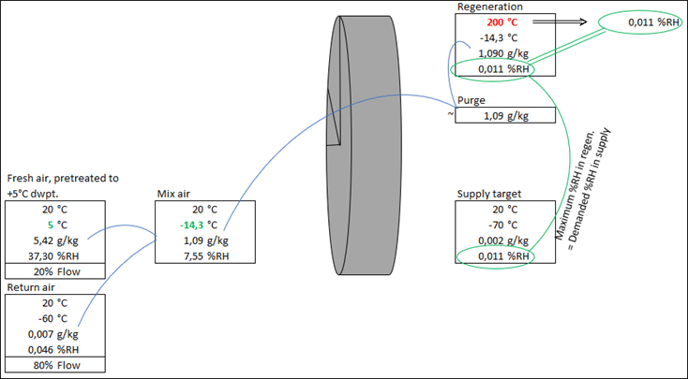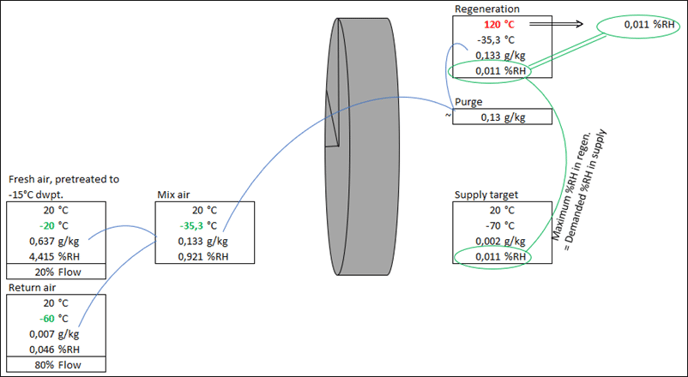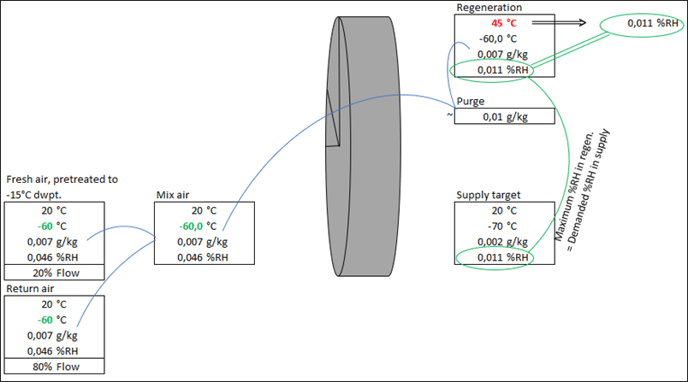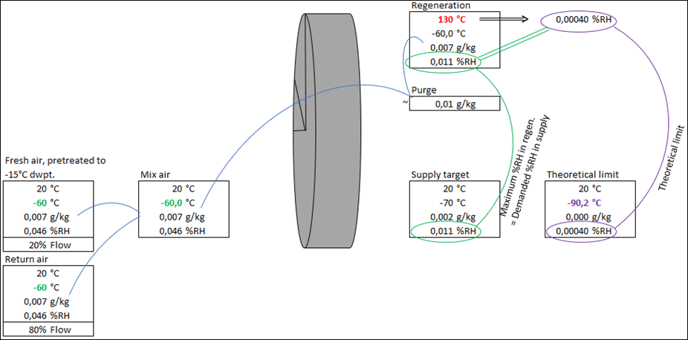It is all based on the relative humidity within the system. The relative humidity is the driver to remove moisture from the surface of the rotor. The limiting factor of the system is the relative humidity of the regeneration air flow. In the ideal world, the rotor is simply converting this relative humidity to another, lower temperature at supply air.
To compare all three rotor solutions the requirements are set as the following:
- Return air from the dry room with dew point: -60°C
- Supply air to the dry room with dew point: -70°C
- Temperature in dry room: 20°C
- Relative humidity in supply air: 0,011 %RH
- Fresh air required is 20% of the volume flow
Example 1 – 1 Rotor system
1 Rotor systems usually use a semi-open purge to balance things out. This keeps fresh air from mixing in too much but also adds more moisture because the outside air is more humid than the initial 1.09 g/kg. This makes it even harder for the system to reach the target. In real-life situations, 1 Rotor systems struggle when dealing with supply air conditions ranging from -45 to -50°C dewpoint.

Example 2 – 2-Rotor system
When the air is cooled and treated by one adsorption wheel before mixing, we can expect a dewpoint of around -20°C. After mixing, we end up with 0.133 grams of moisture per kilogram.
To achieve a low humidity of 0.011%RH in the regeneration air, we need to increase the temperature to 120°C. This temperature is more practical for everyday operation. For real-world effectiveness, we would suggest aiming for a slightly higher temperature range of 130 to 140°C in the regeneration air. While this temperature range can be achieved using electricity, it might be challenging with heated water.
This is where a three-rotor solution shines as the preferred method for drying, enabling the utilisation of waste heat for hot water, thereby requiring only 45°C to achieve a dew point of -70°C in the supply air.

Example 3
3-Rotor system at low temperature
Utilising a cooler alongside two adsorption wheels enables us to attain air conditions akin to those of the target room before mixing. Post-mixing, the humidity measures at 0.007 grams per kilogram. To ensure a humidity level of 0.011%RH, a regeneration temperature of 45°C is required.
This temperature can often be achieved through various means such as waste heat water from cooling ovens or other equipment, district heating, or heat pumps, which are typically more economical than electricity. While in practical terms, slightly higher temperatures may be necessary for the system to operate effectively in real-life scenarios, these can generally be accommodated with waste heat water."

3-Rotor at high temperature
Continuing with Example 3 about the 3-Rotor system at higher temperatures:
When we run at low temperatures, it means we have a lot of room to adjust the temperature settings. If we boost the regeneration air temperature to 130°C, the relative humidity drops to 0.0004%. To put it simply, in this case, it's like having a dewpoint of -90.2°C when the dry bulb temperature is 20°C.

Learn more about the various rotor solutions here, and see the possibilities with a 3-rotor solution.
